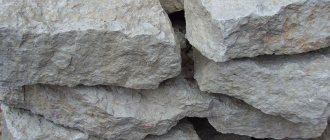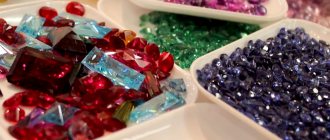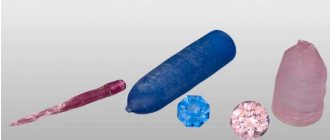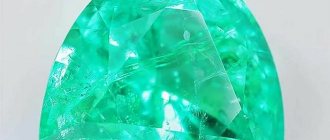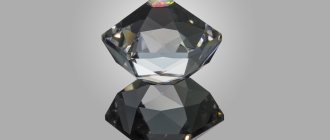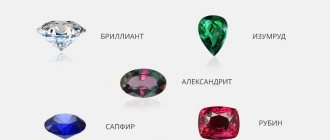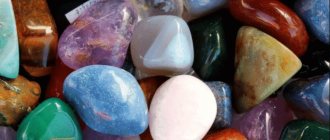The actual price of a stone is determined by its individual characteristics, weight, cost of cutting, as well as changing market conditions, which depend on fashion, advertising and a number of other factors. The cost of spinel, tanzanite, tourmaline, opal, zircon, peridot and many other “semi-precious” stones of good quality is sometimes also very high. Once cut, polished and set in a setting, the gemstone becomes the main part of the jewelry. Along with precious ones, there are so-called. jewelry and ornamental stones, from which, in addition to jewelry, larger stone-cutting products are also made. In addition to minerals, these stones also include some rocks (for example, jasper, rhodonite, lapis lazuli, etc.).
Since prehistoric times, people have been attracted to unusual stones; in many ancient cultures they were attributed supernatural properties, used as amulets that protect against evil spirits and promote healing, or as talismans that bring good luck, success in business, or victory in war. For example, in Ancient Egypt, a scarab beetle carved from lapis lazuli or carnelian was considered a symbol of the immortality of the soul. Prayers and spells were engraved on precious stones; they played an important role in religious rituals. In ancient times, seals carved on stone replaced a personal signature. Scenes from the life and everyday life of the peoples of Ancient Greece and Rome skillfully engraved on precious stones allow us to learn interesting details regarding the history and culture of the ancient Mediterranean.
Some precious stones were so expensive that they were a recognized means of exchange, valuable diplomatic gifts that sealed peace, or were the cause of strife and war (especially when it came to owning the mines where the stones were mined). Often the power of ruling dynasties rested on their treasures. The Phoenicians went on ships to the Baltic countries in search of amber. Ruby, almandine, amethyst, beryl became famous in Europe after the campaigns of Alexander the Great in Asian countries. The Indians of pre-Columbian America mined emeralds, which appeared in abundance in Spain, Portugal, and Germany following the colonization of Colombia, Peru, and Mexico.
Nature of stones
Most gemstones are minerals, i.e. homogeneous natural chemical compounds that have a certain composition and crystal structure, on which the shape of the crystals and their properties depend. Natural volcanic glasses (for example, obsidian) belonging to rocks are used as ornamental stones. Four jewelry stones - pearl, coral, amber and jet - are of organic origin; they are formed by living organisms - plants or animals. Finally, jewelry stones can be artificial, man-made. Minerals of the same type can have varieties. Varieties of corundum include ruby and sapphire, which are identical in all properties except color - ruby is deep red, and classic sapphire is cornflower blue. Also, in addition to blue sapphires, transparent corundums of any color except red are included, i.e. green, yellow, purple, orange, pink. The group of quartz is very extensive, including transparent crystalline varieties (rock crystal, amethyst, citrine, rose and smoky quartz) and fine crystalline varieties (chalcedony, carnelian, chrysoprase, agate and onyx), as well as such extraordinary varieties of quartz with inclusions of foreign minerals, such as aventurine, tiger's eye, hairy, etc. Most gemstones are very resistant to chemical attack, and therefore their beauty is long-lasting and reliable.
The standard unit of mass in the gemstone market is the metric carat. Initially, it corresponded to the standard weight of carob seed (200 mg), common in the Mediterranean. A carat is divided into 100 shares. The weight of more valuable jewelry stones in commercial transactions is determined in carats, less valuable - in grams. Some cut stones are valued by size, measured in millimeters. The quarter-carat pearl serves as the unit of measurement for valuing commercial pearls. Hardness is determined by the mineral's resistance to scratching. The harder the gemstone, the higher the quality of its polishing and the more beautiful and durable it is.
Diamond
A diamond is a transparent artificially cut diamond. The word “diamond” comes from the Greek “indestructible.” And it is no coincidence, because the cubic allotropic form of carbon (this is the scientific definition of diamond) is the hardest mineral on the Mohs scale.
Diamonds are rightfully considered the best among precious stones. The French word brillant itself means “brilliant”, “sparkling” and expresses what diamonds are so valued for: none of the stones has such a deep radiance and such an indescribable play of light. Diamonds are graded using the 4 C system: cut, clarity, color and carat. The higher each characteristic, the closer the diamond is to perfection. Diamonds with 57 facets are called full-cut. They have ideal proportions to achieve maximum brilliance and maximum play of light inside the stone: there are 33 facets on the top of the diamond and 24 on the bottom. Purity is expressed as the absence of defects or foreign inclusions. A perfect diamond is called a pure diamond.
By color, diamonds are divided into traditional (colorless and all shades of yellow) and fancy (pink, blue, indigo and even green). The weight of diamonds is measured in carats (1 carat equals 0.2 grams). Diamonds pair perfectly with most gemstones and especially well with emeralds, sapphires and rubies.
Origin of gems
There are many ways in which gemstones are formed in nature. Some of them arose as a result of powerful mountain-building processes, including tectonic movements, earthquakes and volcanic eruptions. Others are the products of sedimentation from mineral spring waters or the slow burial of ancient forests. Almost all gemstones are associated with certain rocks of the earth's crust, divided into three main types: igneous (igneous), sedimentary and metamorphic. Amber is the resin of ancient coniferous trees; It often contains inclusions of perfectly preserved insects. Jet, which is close in composition and origin to ordinary coal, differs from it in its denser composition.
Distribution of gemstones
It was long believed that beautiful gemstones only formed in tropical climates because the best gemstones in the past came from India, Burma and Ceylon. This idea was then refuted by geologists, who showed that climate has nothing to do with the quality of gems, since most stones are formed in the bowels of the Earth. For many centuries, the East has been famous for its precious stones. India was the first major source of diamonds, which are still mined there today; Ruby, sapphire and other stones were also discovered on its territory. Almost all the important types of jewelry stones, with the exception of diamond, are found in Sri Lanka, which the Chinese call the “island of precious stones.” The world's best rubies come from Myanmar.
More than half of the world's sapphire production comes from Indochina, although most of the largest stones come from India. Many sapphires are mined in Myanmar and Sri Lanka, where star sapphire is predominantly sourced. Spinel, commonly associated with precious corundums, is mined in Thailand, Sri Lanka and Myanmar. Jade is imported mostly from Myanmar, with a significant amount also supplied by China. In the vast expanses of the Asian part of Russia, many jewelry stones are mined: Yakut diamonds, Transbaikal aquamarines, topazes, Sayan jade, Baikal lapis lazuli. The Urals are rich in stone treasures: emeralds, chrysoberyl, amethysts, rock crystal, jasper, malachite, demantoid and many other precious stones are common there.
In Afghanistan, there have been mines producing high-quality lapis lazuli for more than 6,000 years, which were visited by Marco Polo. The best quality turquoise, which served as the standard for this stone, has been mined for a long time in Iran (Persian turquoise). The island of Zeberged in the Red Sea was for a long time the only place from which jewelry olivine, chrysolite, came. In recent years, chrysolite (peridot) from diamond-bearing kimberlites of Siberia and South Africa has been developed. Australia is famous for its deposits of precious opal (New South Wales, South Australia and Queensland), deep blue sapphires and rich fisheries for natural pearls. The leading producer of cultured pearls is Japan, which also produces precious coral, rock crystal and amethyst. South Africa has the world's largest diamond mines. Along the way, some other precious stones are also mined there. From the island of Madagascar comes the world's most beautiful tourmaline, a rare pink variety of beryl - morganite and beautiful rock crystal. Europe has a number of famous deposits of precious stones: amber on the Baltic coast, opal in Hungary, pyrope in the Czech Republic, noble coral in the coastal waters of Italy, agates in Germany, chrysoprase in Poland, rock crystal in Switzerland, topaz and beryl in Ukraine.
South America is very rich in precious stones. Particular mention should be made of the diamonds of Brazil, where topaz, aquamarine and most of the amethyst and citrine also come from. Brazil and Uruguay are famous for agates. The world's best emeralds are mined in Colombia. Chile supplies significant quantities of lapis lazuli. Mexico is the main source of fire opal and the very rare transparent sphalerite (almost half of the world's production), as well as ornamental stones, such as Mexican onyx. In the United States, the states of Maine, California, Colorado and North Carolina are rich in a variety of precious stones. Maine is the only state where violet apatite crystals are mined, and they also produce garnets, sodalite and magnificent tourmalines. The greatest variety of gemstones is found in California, famous for tourmaline, jade and quartz family minerals. Near the top of Mount Antero (altitude approx. 4300 m) in Colorado, which occupies one of the first places in reserves of precious stones (topaz, tourmaline, kunzite, turquoise, smoky quartz, ornamental alabaster), the highest mountain deposit of selected aquamarines in North America is located. North Carolina has found small quantities of sapphire, emerald, aquamarine and amethyst, as well as unique occurrences of giddenite (a green variety of the precious spodumene); Rhodolite (a pink variety of garnet) was also found here for the first time. Arkansas is the leading quartz crystal mining region in the United States and is home to North America's only source of diamonds. Finds of bright blue sapphire and moss agate are known from Montana. South Dakota supplies rose quartz, Nevada - turquoise and magnificent black opal. Arizona is famous for gemstones such as turquoise and chrysocolla (which contain copper), as well as stones from the quartz family, which include beautiful examples of petrified wood in a variety of colors. Large quantities of jade are exported from Alaska annually; Wyoming jade is also known. Oregon ranks first (in value terms) in the production of jewelry stones (mainly agates) in the United States. However, agates and other quartz family gemstones are found in all western states. From Canada come fine petrified wood, sodalite and jade, as well as labradorite.
Pearl
Pearl is the most mysterious jewelry stone, the embodiment of beauty and romance. It has never gone out of fashion and goes with both an evening outfit and an office suit. Style icons of all times, from Cleopatra to Coco Chanel, appreciated its warm, pearlescent shine. The word “pearl” itself is used to emphasize uniqueness and beauty.
Altyn brand products use cultured pearls of natural origin. Cultured pearls are pearls grown in natural conditions, but with some human assistance. It is necessary that pearls, for which they once dived into the depths, are now practically not mined. Back in the fifties of the last century, its production was banned internationally.
The cost of a “wild” pearl is from 100 to 100,000 dollars, and its difference from a cultured one can only be noticed by professionals under X-ray! Therefore, more than 90% of pearls in the jewelry world today are cultured. According to the technology invented by Japanese scientists, shell crumbs are introduced into the Pinctadamartensi oyster. And then the mollusks are placed in nets, fed, examined, treated for parasites, even the water is heated in the open sea... This is how a cultured pearl is born - just like thousands of years ago. Therefore, you can always be sure that when purchasing jewelry with pearls at Altyn, you will receive products with natural pearls at the best prices.
Processing of jewelry stones
The art of cutting involves cutting and polishing jewelry stones. Their processing is divided into the production of cabochons, the actual cutting (faceted) and engraving or stone carving. Cabochon is the most ancient and simplest method of processing: the top of the stone is given a rounded shape. Faceted cutting (from the French facette - facet) consists of applying a certain number of flat, smooth edges to the stone. This process requires mathematical precision and great skill. Engraved stones (or gems) are divided into intaglios with an in-depth image and cameos with a convex relief. The facet cut is used primarily for clear stones with a bright luster, such as diamond and emerald; at the same time, their innermost beauty is better revealed and maximum play of light is achieved. Opaque and translucent stones are usually processed in the form of a cabochon; round or cylindrical beads are also made from them. The art of symmetrical diamond cutting has evolved over the centuries, from simply polishing the natural facets of the crystal to the modern American diamond cut, which maximizes the natural qualities of the stone. Dyed gemstones, such as emerald, ruby and sapphire, are given a step cut - square or rectangular. Diamond cutting is a very special type of processing that has developed into an independent branch of the industry, since the extremely high hardness of diamond requires special skills and the use of cutting machines and technical devices that are not needed when processing softer jewelry stones.
The main factors determining the value of a stone are: 1. origin (natural or synthetic). A stone that was found in the bowels of the Earth will be valued much more than its synthetic counterpart grown in a laboratory, because more labor must be spent searching for and extracting natural stones than growing an artificial crystal. The supply of gems in natural deposits is limited and is constantly being depleted. As deposits are depleted, the value of the stone increases; 2. its prevalence in nature. The rarer a stone is found in nature, the fewer deposits there are, the higher its value. 3. the quality of the raw materials from which it was cut. Natural stones are of jewelry and ornamental quality. Jewelry-quality stones have a high degree of purity, that is, transparent, free of cracks and inclusions. Such gems are distinguished by their bright, saturated color, evenly distributed throughout the entire volume of the stone.
Wear resistance of gems
The less strength a stone has, the less valuable it is: when processing a gem for jewelry, it is very important that it can be cut, sawed, polished, etc. without much fear. Thus, according to hardness, gems are divided into the following types:
- Soft (from 1 to 5) – talc, lime spar, marble, onyx;
- Medium (from 5 to 6.5) – apatite, orthoclase;
- Hard (from 6.5 to 7.5) – quartz;
- High hardness (more than 7.5) – topaz, sapphire, diamond.
The quality of precious and semi-precious stones is influenced by their property, such as viscosity - the ability to change and restore shape during the action of deforming forces on them. Gems with high viscosity (jade) easily retain their shape, and you can wear them without fear that they will begin to crumble, as, for example, fragile semi-precious stones such as opal or obsidian can do.
Jewelers also value such a property of a stone as cleavage - its ability to break into crystallographic plates (a very necessary property for obtaining a flat surface). Meanwhile, if this characteristic is expressed too strongly, jewelers prefer not to mess with the gem: the stone may become covered with cracks and chips.
One of the characteristics of the strength of a gem is its purity or defectiveness - the absence of voids, cracks, and impurities. It is worth considering that an absolutely pure mineral is almost never found and always contains traces of the early stages of its development.
Cracks rarely decorate a gem and always reduce its strength - this also applies to expensive diamonds.
Thus, the most expensive gem “Cullinan” (the diamond received its name in honor of the owner of the mine where it was discovered) was presented to King Edward VII of Great Britain at the beginning of the twentieth century: it had 3106 carats, its weight exceeded half a kilogram, and its dimensions were 100x65x50 mm. Since the donated diamond had cracks, it was impossible to make one large diamond from it, and therefore, before splitting it, the best lapidary of the time, Joseph Ascher, studied it for several months.
It was not possible to break it right away: during the first attempt, the knife broke. But the second approach turned out to be more successful, and Cullinan divided it into two parts (interestingly, after the first accurate blow, the master lost consciousness from overexertion). As a result, nine large diamonds and ninety-six small gems were made from the stone, the largest of which is set in the royal scepter, and the second largest adorns the crown of the British Empire.
DIAMOND
The name of the mineral comes from the Greek word “adamos”, irresistible, indestructible (synonyms: adamant, demant, diamond). Over time, the word “adamos” takes on a new form: “diamond”. Cut, clear, gem-quality diamonds are called brilliants. The term appeared in the 17th century after the invention of the diamond cut. Since ancient times, diamond has been considered a high-class gemstone. Many mystical properties were attributed to this mineral. In India and Iran, there was a custom - on the day when a newborn was given a name, the father sprinkled a pinch of diamond dust on his head, thereby ensuring the child’s health, well-being and long life. In ancient India, diamonds were believed to be formed from the “five principles of nature” - earth, water, sky, air and energy.
Aquamarine
Pliny the Elder gave a romantic and very appropriate name to aquamarine. The romantic name “aquamarine” was first used by the ancient Roman historian Pliny the Elder. This unusual gem reminded him of the pure green waters of the sea. Aquamarine - beryllium aluminosilicate with a ring structure - belongs to valuable jewelry stones. One of the largest aquamarines still adorns the crown of the Queen of England, adjacent to diamonds and rubies. This beautiful stone is considered the ruler of the water element, the stone of purposeful and lucky people.
RUBY
Ruby is a red stone with a purple sheen. Ruby personifies passion and, as a talisman, can bring happiness in love. “If you want to achieve reciprocity, give him or her to whom your heart is inclined a ruby the color of a flame and you will kindle love in her,” astrologers advised. According to the psychological and physiological influence on a person, the red color of ruby is exciting and passionate, the most active, hot and energetic, the color of valor and courage, strength and bravery. Ruby was the favorite stone of the Roman Empire. Ruby symbolizes love and health, beauty and dignity, strength and royalty, passion and passion. Ruby is an extremely rare and expensive stone; until the beginning of the last century, it was valued significantly higher than diamond. Large rubies are found in nature much less frequently than diamond crystals of similar size. The most prized ruby is the “pigeon blood color” - deep red with a slight purple tint.
Onyx
Onyx is one of the varieties of agate. Its distinctive feature is stripes of red, white, brown, and black. It is believed that the thinner the stripes, the greater the value of the stone. Depending on the color of the stripes, this gem has many names: chalcedony-onyx (layers of sky blue coloring alternate with gray and white stripes), Arabic (white stripes harmonize with black shades), carnelian-onyx (a combination of gray and white stripes), carnelian (alternating red and white layers), sardonyx (stripes of white and brown colors).
Black onyx is especially valuable. He is truly stunningly handsome! Coal black color favorably sets off a woman’s delicate skin, emphasizes facial features and eye color. Convince yourself of the beauty of this stone by looking at these jewelry from the Altyna collections!
The luxurious black stone attracts all the rays from the surrounding space. Its velvety black depth absorbs all shades of the color palette. And among the magical properties they note the ability to increase internal energy and give strength. Perhaps this is why stylish products with black onyx are appreciated and often chosen by men.
SAPPHIRE
In ancient times, sapphire was considered a symbol of the heavenly dome, a stone of reflection and contemplation. The dark blue sapphire, in which the wisdom of the past is closely intertwined with the mystery of the invisible distant future, was considered the “talisman of the wise.” It promotes the development of warmth and kindness, attracts friends to its owner and repels enemies. Jewelers call “sapphire” to mean corundum, which has a blue color. Actually, only blue and light blue stones can be called sapphire. But there are sapphires of other colors. In this case, the color of the stone is indicated first. For example - “yellow sapphire”, “white sapphire”. Natural sapphire is a very rare and expensive stone, especially Kashmir (India) cornflower blue. Like ruby, sapphire can give the effect of asterism. Such sapphires are called star sapphires. The radiant glow in the center, formed as a result of the intersection of three silver lines, symbolizes faith, hope, love.
Amethyst
Amethyst is the most beautiful of quartzes with colors ranging from violet and dark purple to pink. The beautiful purple or cherry blue color of amethyst, which distinguishes it from simple quartz and rock crystal, is due to traces of iron and manganese oxides. In jewelry, the most prized amethysts are their lilac, violet, and pinkish-purple colors.
In ancient times, amethysts symbolized connection with higher powers. The reverent attitude towards amethysts continued later. They were often used to decorate the rings of priests and especially important church attributes: crosses, icons, bowls... Perhaps the reason for this is the deep and unusual purple color of amethyst - a symbol of purity, devotion and optimism.
Amethyst is the favorite stone of European jewelers. It never goes out of style. Jewelry with amethysts appears annually in the collections of Cartier and Boucheron, VanCleef and Bvlgari. Moreover, purple amethysts are used to create expensive jewelry.
A favorite of jewelers, amethyst requires a special approach. It is not advisable to store jewelry with amethysts in direct sunlight; its color may lose saturation. But at the same time, all the depth and beauty of the stone is revealed precisely in daylight!
EMERALD
Emerald is the most expensive variety of beryl, an amazingly colored gem. In the old days it was called smaragd. This is an extremely rare gem. An emerald without flaws has become a proverb as unattainable perfection, since it almost always has defects. The treasuries of the Shahs of Iran and the Russian Tsars were famous for their priceless emeralds. Emeralds were found in the tombs of Egyptian pharaohs, at excavations in Pompeii and Herculaneum. From prehistoric times to the present day, emerald has maintained a prominent position in the gem market, especially in the East. The influence of the green color of emerald on a person is very favorable. The green color of emerald is a symbol of hopes and memories, it is a symbol of life, harmony and peace.
The color intensity of emeralds can vary. In jewelry, emeralds are used ranging from faint green to rich emerald color. With the same degree of transparency, defects (presence of cracks and inclusions) and size, the cost of the stone is higher, the more intense its color, and the difference in the cost of different shades is very significant.
Rauch-topaz
The name “rauchtopaz” has been established in jewelry for a long time, although these beautiful stones have nothing to do with topaz. Their second name is more correct - smoky quartz or smoky crystal. It perfectly emphasizes both the composition and the peculiarity of this stone. Rauchtopazes range from a barely noticeable smoky to brown and deep chocolate color. This stone looks like frozen clots of smoke left over from unknown, but undoubtedly majestic bonfires.
This is exactly how it was perceived in ancient times. In the Far East, rauchtopaz is considered the stone of Buddha; here it is credited with mystical and healing properties that help to achieve nirvana. In Scotland it is called the Cairngorm Stone and is used to adorn national costumes. And in Russia, jewelry with rauchtopaz became especially popular under Catherine the Great and never went out of fashion.
The closest “relatives” of rauchtopaz are rock crystal, citrine and amethyst; their chemical composition is also silicon oxides. Already in the 18th century, Ural craftsmen turned rauchtopazes into citrines by heat treatment: they wrapped them in dough and baked them in an oven. Rauchtopazes are very durable: the hardness index is 6.5–7 on the Mohs scale. But, like many other stones, they are fragile and require careful handling. Rauchtopaz crystals are often collected, inlaid in gold, and less often in platinum and silver.
A stone of contemplation and peace, optimism and inspiration, a stone of sages and artists, rauchtopaz is equally often used in both men's and women's jewelry.
ALEXANDRITE
Alexandrite is a rare jewelry variety of chrysoberyl - a transparent stone. It has a grassy green color in daylight and crimson red in artificial light.
Alexandrite is considered a truly outstanding gemstone due to its historical origins. It was found in 1830 in the Urals. Since green and red were considered imperial colors in Tsarist Russia, the stone was named in honor of Emperor Alexander II. In India, alexandrite symbolizes longevity and prosperity; it is believed that it stimulates the brain and pacifies the soul. In Europe, alexandrite is a symbol of falling in love and at the same time jealousy. Currently, good quality alexandrites (not fixed in antique products) are extremely rare. The stones sold in jewelry before 1973 as alexandrite were actually varieties of synthetic spinel and synthetic corundum with vanadium added. In 1973, products with synthetic alexandrites appeared on the market, which also have a spectacular color change, but from purple-blue to pink, rather than from green to red. Technologies for growing alexandrites, which are very close in their properties to natural ones, are complex and very expensive, and therefore the price of synthetic alexandrites is such that it allows them to be used as central stones in expensive jewelry set with diamonds. The main deposit of alexandrite is located in Russia in the Urals (Malyshevo). Malyshevsky alexandrites are found in mica schists along with emerald and phenacite. Later, alexandrite crystals were found in Brazil, as well as in Ceylon and Madagascar. Isolated finds of this mineral are known in India, South Africa and Tanzania, but the “Alexandrite effect” of these stones is very insignificant. Processed in the form of cabochons, cutting is also used.
Story. Legends. Beliefs.
Stones have their own history. The history of emerald is one of the oldest. The very first information about emeralds dates back to the times of Ancient Egypt.
Treasures of the Queen of Sheba
Back in the 3rd millennium BC, emerald was known to the Egyptians and other ancient civilizations. Most of the emerald deposits known at that time were located in the region of Upper Egypt, near the Red Sea. One of the most famous deposits was discovered in Mount Zabara and, according to legend, belonged to the Queen of Sheba. It was believed that the emeralds located in this mountain are protected by evil spirits. Tradition says that depending on the time of year, these stones either increased or decreased, and their color changed along with the phases of the moon.
For many centuries this deposit was abandoned and its location forgotten. The location of the ancient mine was rediscovered after the French traveler and explorer M. Caillot was invited to Egypt, who found it in 1818 and also sketched samples of the tools he found in the mine workings. He became convinced that for a long time the mine was considered abandoned, but there was a period when it was secretly discovered and the deposit continued to be developed.
The ancient Egyptian Book of the Dead recorded that the Egyptians received an emerald as a gift from the great god Thoth. The green color of the stone is reminiscent of spring, and it was considered a symbol of eternal youth.
Therefore, the Book of the Dead ordered embalmers to place an emerald on the neck of the mummy so that the soul, during its long journey through the afterlife, would retain youth and strength and be protected from danger.
This stone was revered by all world religions, including Christian, and therefore the emerald has always been shrouded in a certain mystical aura. For example, it was worn as an amulet to create an elevated mood in its owner. Andrew, Bishop of Caesarea, dedicated the emerald to the Apostle John for its ability to soften and pacify the souls of sinners.
According to the Bible, the breastplate of the great Jewish high priest was decorated with twelve different precious stones, each of which was engraved with the name of one of the tribes of Israel. The name of Gad was engraved on the emerald. It was also believed that the New Jerusalem would rest on twelve foundations, richly decorated with precious stones, and the fourth of them would be emerald.
Muslims also used gemstones to focus on religious meditation and believed that the emerald represented the fourth heaven. In India, offering an emerald to God gave the giver knowledge of the secrets of the soul and eternal life.
Conquistadors
The Spanish conquerors, who devastated in the 16th century. South America, magnificent emeralds were found there. The indigenous people of the Manta Valley in Peru kept a huge emerald that inspired awe in all who were privileged to look at it. According to legend, it was the size of an ostrich egg and bore the name of the goddess Esmeralda. People worshiped him during religious celebrations and brought their “goddess” as gifts of small emeralds - the “daughters” of the goddess.
During the conquest of Peru, the Spanish army destroyed the Temple of the Sun, stealing many emeralds from there, but no source indicates that they discovered the Temple of Esmeralda. To save their goddess from the conquistadors, the priests hid the object of their worship so much that to this day Esmeralda and her temple have not been discovered.
The birthplace of the legendary treasures of Esmeralda is also the birthplace of all sorts of legends about the emerald. The Peruvians believed that emeralds ripened like fruit. [8]
Emerald is a precious stone that can reveal the secrets of the future and enlighten the mind of the owner. Frees from melancholy and hypochondria, drives away bad dreams, saves from the treachery of love, fever, leprosy, strengthens the heart, eliminates rowing, saves from seizures and evil spirits. The stone is a powerful talisman, healing for vision, and a remedy for the bites of poisonous animals. This is a stone of wisdom, composure, hope. Anyone who constantly wears an emerald becomes a long-liver and is always in a good mood. A stone set in gold protects against evil love spells, infidelity and lies.
In the old days, emerald was considered a powerful talisman, healing for vision, and a remedy for the bites of poisonous animals (one type of which was supposedly fatal to poisonous snakes). According to ancient Russian beliefs, emerald is a stone of wisdom, composure and hope.
Modern occultists see a definite connection between this stone and the unconscious actions of man. The ancients called it the “stone of Isis.” It is considered a talisman of mothers and sailors; people looked at it for a long time, it was believed that everything secret was reflected in it, like in a mirror, and the future was revealed in advance. To strengthen memory and sharpen vision, it was worn around the neck. Set in gold, it protects against contagious diseases, love spells and insomnia. Young virgins were forced to wear an emerald so that it would protect them from debauchery and protect chastity. It is believed that the dreams of a person wearing an emerald are especially likely to come true.
He protects those born in September from deceitful friends and gives them loyalty. However, in order for this stone to fully manifest itself, it is necessary that the Moon be in a favorable position in the horoscope. The special protective properties of the emerald lie in the fact that it actively fights against the deceit, unchastity and infidelity of its owner, being unable to resist them, it splits; it is anti-demonic in nature.
As for its medicinal properties, it dispels melancholy and gives longevity[5]

